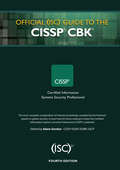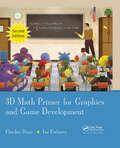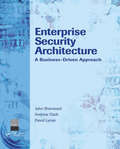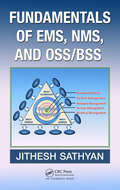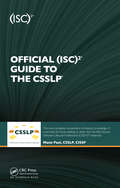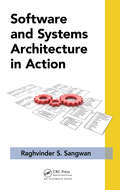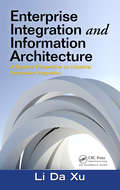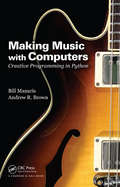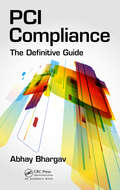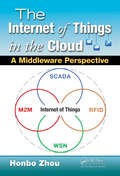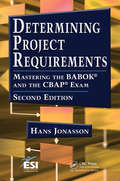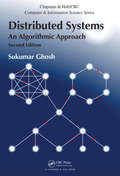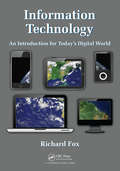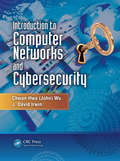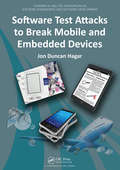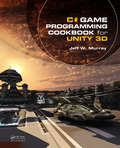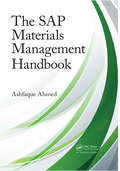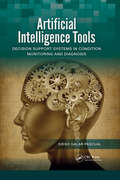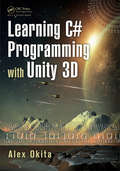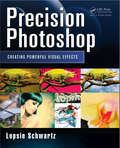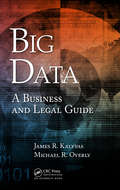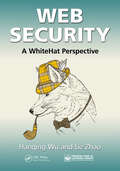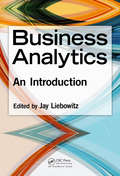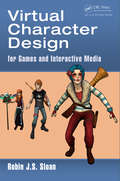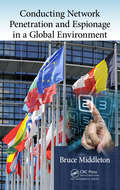- Table View
- List View
Official: Guide to the CISSP CBK ((ISC)2 Press)
by Adam Gordon<p>As a result of a rigorous, methodical process that (ISC)² follows to routinely update its credential exams, it has announced that enhancements will be made to both the Certified Information Systems Security Professional (CISSP) credential, beginning April 15, 2015. (ISC)² conducts this process on a regular basis to ensure that the examinations and subsequent training and continuing professional education requirements encompass the topic areas relevant to the roles and responsibilities of today’s practicing information security professionals. <p>Refreshed technical content has been added to the official (ISC)² CISSP CBK to reflect the most current topics in the information security industry today. Some topics have been expanded (e.g., asset security, security assessment and testing), while other topics have been realigned under different domains. The result is an exam that most accurately reflects the technical and managerial competence required from an experienced information security professional to effectively design, engineer, implement and manage an organization’s information security program within an ever-changing security landscape.</p>
3D Math Primer for Graphics and Game Development (Wordware Game Math Library)
by Ian Parberry Fletcher DunnThis engaging book presents the essential mathematics needed to describe, simulate, and render a 3D world. Reflecting both academic and in-the-trenches practical experience, the authors teach you how to describe objects and their positions, orientations, and trajectories in 3D using mathematics. The text provides an introduction to mathematics for
Enterprise Security Architecture: A Business-Driven Approach
by Nicholas SherwoodSecurity is too important to be left in the hands of just one department or employee-it's a concern of an entire enterprise. Enterprise Security Architecture shows that having a comprehensive plan requires more than the purchase of security software-it requires a framework for developing and maintaining a system that is proactive. The book is based
Fundamentals of EMS, NMS and OSS/BSS
by Jithesh SathyanIn this era where data and voice services are available at a push of a button, service providers have virtually limitless options for reaching their customers with value-added services. The changes in services and underlying networks that this always-on culture creates make it essential for service providers to understand the evolving business logi
Official ((isc)2 Press Ser.)
by Mano PaulAs the global leader in information security education and certification, (ISC)2 has a proven track record of educating and certifying information security professionals. Its newest certification, the Certified Secure Software Lifecycle Professional (CSSLP) is a testament to the organization's ongoing commitment to information and software security
Software and Systems Architecture in Action (Applied Software Engineering Ser.)
by Raghvinder S. SangwanModern-day projects require software and systems engineers to work together in realizing architectures of large and complex software-intensive systems. To date, the two have used their own tools and methods to deal with similar issues when it comes to the requirements, design, testing, maintenance, and evolution of these architectures.Software and
Enterprise Integration and Information Architecture: A Systems Perspective on Industrial Information Integration (Advances In Systems Science And Engineering (asse) Ser.)
by Li Da XuEnterprise solutions have emerged as promising tools for integrating and extending business processes across business functions. Supplying a clear and comprehensive introduction to the field, this book provides a detailed description of enterprise information integration-from the development of enterprise systems to extended enterprise information
Making Music with Computers: Creative Programming in Python (Chapman And Hall/crc Textbooks In Computing Ser. #13)
by Bill ManarisTeach Your Students How to Use Computing to Explore Powerful and Creative IdeasIn the twenty-first century, computers have become indispensable in music making, distribution, performance, and consumption. Making Music with Computers: Creative Programming in Python introduces important concepts and skills necessary to generate music with computers.
PCI Compliance: The Definitive Guide
by Abhay BhargavAlthough organizations that store, process, or transmit cardholder information are required to comply with payment card industry standards, most find it extremely challenging to comply with and meet the requirements of these technically rigorous standards. PCI Compliance: The Definitive Guide explains the ins and outs of the payment card industry (
The Internet of Things in the Cloud: A Middleware Perspective
by Honbo ZhouAlthough the Internet of Things (IoT) is a vast and dynamic territory that is evolving rapidly, there has been a need for a book that offers a holistic view of the technologies and applications of the entire IoT spectrum. Filling this void, The Internet of Things in the Cloud: A Middleware Perspective provides a comprehensive introduction to the Io
Determining Project Requirements: Mastering the BABOK and the CBAP Exam (Esi International Project Management Ser.)
by Hans JonassonGood requirements do not come from a tool, or from a customer interview. They come from a repeatable set of processes that take a project from the early idea stage through to the creation of an agreed-upon project and product scope between the customer and the developer.From enterprise analysis and planning requirements gathering to documentation,
Distributed Systems: An Algorithmic Approach, Second Edition (Chapman And Hall/crc Computer And Information Science Ser.)
by Sukumar GhoshDistributed Systems: An Algorithmic Approach, Second Edition provides a balanced and straightforward treatment of the underlying theory and practical applications of distributed computing. As in the previous version, the language is kept as unobscured as possible-clarity is given priority over mathematical formalism. This easily digestible text:Fea
Information Technology: An Introduction for Today's Digital World
by Richard FoxInformation Technology: An Introduction for Today's Digital World introduces undergraduate students to a wide variety of concepts they will encounter throughout their IT studies and careers. The book covers computer organization and hardware, Windows and Linux operating systems, system administration duties, scripting, computer networks, regular ex
Introduction to Computer Networks and Cybersecurity
by Chwan-Hwa John WuIf a network is not secure, how valuable is it? Introduction to Computer Networks and Cybersecurity takes an integrated approach to networking and cybersecurity, highlighting the interconnections so that you quickly understand the complex design issues in modern networks. This full-color book uses a wealth of examples and illustrations to effective
Software Test Attacks to Break Mobile and Embedded Devices: Software Test Attacks To Break Mobile And Embedded Devices (Chapman And Hall/crc Innovations In Software Engineering And Software Development Ser. #6)
by Jon Duncan HagarAddress Errors before Users Find ThemUsing a mix-and-match approach, Software Test Attacks to Break Mobile and Embedded Devices presents an attack basis for testing mobile and embedded systems. Designed for testers working in the ever-expanding world of "smart" devices driven by software, the book focuses on attack-based testing that can be used by
C# Game Programming Cookbook for Unity 3D
by Jeff W. MurrayAn Accessible, Modular Style of Game Building-Easily Start Making Games with Unity 3DC# Game Programming Cookbook for Unity 3D presents a highly flexible core framework to create just about any type of game by plugging in different script components. Most scripts function within the game framework or in your own structures. The techniques and conce
The SAP Materials Management Handbook
by Ashfaque AhmedAlthough tens of thousands of global users have implemented Systems, Applications, and Products (SAP) for enterprise data processing for decades, there has been a need for a dependable reference on the subject, particularly for SAP materials management (SAP MM).Filling this need, The SAP Materials Management Handbook provides a complete understandi
Artificial Intelligence Tools: Decision Support Systems in Condition Monitoring and DIagnosis
by Diego Galar PascualArtificial Intelligence Tools: Decision Support Systems in Condition Monitoring and Diagnosis discusses various white- and black-box approaches to fault diagnosis in condition monitoring (CM). This indispensable resource:Addresses nearest-neighbor-based, clustering-based, statistical, and information theory-based techniquesConsiders the merits of e
Learning C# Programming with Unity 3D
by Alex OkitaDesigned to give you enough familiarity in a programming language to be immediately productive, Learning C# Programming with Unity 3D provides the basics of programming and brings you quickly up to speed. Organized into easy-to-follow lessons, the book covers how C# is used to make a game in Unity3D. After reading this book, you will be armed with
Precision Photoshop: Creating Powerful Visual Effects
by Lopsie SchwartzThe Essentials of Photoshop for Creative ProfessionalsThere are plenty of books on Photoshop for photographers; for everyone else, there's Precision Photoshop: Creating Powerful Visual Effects. In clear, conversational language using extensive images and screenshots, this book gives you in-depth guidance on learning how to use Photoshop. The author
Big Data: A Business and Legal Guide
by James R. Kalyvas Michael R. OverlyBig Data: A Business and Legal Guide supplies a clear understanding of the interrelationships between Big Data, the new business insights it reveals, and the laws, regulations, and contracting practices that impact the use of the insights and the data. Providing business executives and lawyers (in-house and in private practice) with an accessible p
Web Security: A WhiteHat Perspective
by Hanqing WuIn late 2013, approximately 40 million customer debit and credit cards were leaked in a data breach at Target. This catastrophic event, deemed one of the biggest data breaches ever, clearly showed that many companies need to significantly improve their information security strategies. Web Security: A White Hat Perspective presents a comprehensive g
Business Analytics: An Introduction
by Jay LiebowitzTogether, Big Data, high-performance computing, and complex environments create unprecedented opportunities for organizations to generate game-changing insights that are based on hard data. Business Analytics: An Introduction explains how to use business analytics to sort through an ever-increasing amount of data and improve the decision-making cap
Virtual Character Design for Games and Interactive Media
by Robin James SloanWhile the earliest character representations in video games were rudimentary in terms of their presentation and performance, the virtual characters that appear in games today can be extremely complex and lifelike. These are characters that have the potential to make a powerful and emotional connection with gamers. As virtual characters become more
Conducting Network Penetration and Espionage in a Global Environment
by Bruce MiddletonWhen it's all said and done, penetration testing remains the most effective way to identify security vulnerabilities in computer networks. Conducting Network Penetration and Espionage in a Global Environment provides detailed guidance on how to perform effective penetration testing of computer networks-using free, open source, and commercially avai
